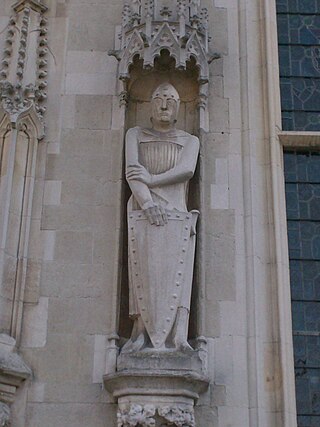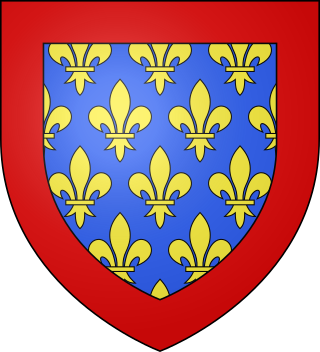Related Research Articles

The Carolingian dynasty was a Frankish noble family named after Charles Martel and his grandson Charlemagne, descendants of the Arnulfing and Pippinid clans of the 7th century AD. The dynasty consolidated its power in the 8th century, eventually making the offices of mayor of the palace and dux et princeps Francorum hereditary, and becoming the de facto rulers of the Franks as the real powers behind the Merovingian throne. In 751 the Merovingian dynasty which had ruled the Franks was overthrown with the consent of the Papacy and the aristocracy, and Pepin the Short, son of Martel, was crowned King of the Franks. The Carolingian dynasty reached its peak in 800 with the crowning of Charlemagne as the first Emperor of the Romans in the West in over three centuries. Nearly every monarch of France from Charlemagne's son Louis the Pious till the penultimate monarch of France Louis Philippe have been his descendants. His death in 814 began an extended period of fragmentation of the Carolingian Empire and decline that would eventually lead to the evolution of the Kingdom of France and the Holy Roman Empire.

Baldwin I, also known as Baldwin Iron Arm, was the first margrave of Flanders, which evolved into the County of Flanders.

The Valois was a region in the valley of the Oise river in Picardy in the north of France. It was a fief in West Francia and subsequently the Kingdom of France until its counts furnished a line of kings, the House of Valois, to succeed the House of Capet in 1328. It was, along with the counties of Beauvais, the Vexin, Vermandois, and Laon, part of the "Oise line" of fiefdoms which were held often by one individual or an individual family as a string of defences against Viking assault on Paris.

Vermandois was a French county that appeared in the Merovingian period. Its name derives from that of an ancient tribe, the Viromandui. In the 10th century, it was organised around two castellan domains: St Quentin (Aisne) and Péronne (Somme). In today's times, the Vermandois county would fall in the Picardy region of northern France.

Ralph I of Vermandois was Count of Vermandois. He was a son of Hugh, Count of Vermandois and his wife, Adelaide, Countess of Vermandois. Ralph was a grandson of Henry I of France, while Ralph's mother had been the Carolingian heiress to Herbert IV, Count of Vermandois.
Herbert IV of Vermandois (1028–1080), Count of Vermandois, was the son of Otto of Vermandois and Parvie.
Adalbert I of Vermandois, was the son of Herbert II of Vermandois and Adela of France. Born about 915, he succeeded his father as Count of Vermandois in 946.

Herbert II, Count of Vermandois, Count of Meaux, and Count of Soissons. He was the first to exercise power over the territory that became the province of Champagne.
Herbert I or Heribertus I, Count of Vermandois, Count of Soissons, and lay abbot of Saint Quentin and Saint-Crépin. He was a Carolingian aristocrat who played a significant role in Francia.
Pepin II was Count of Vermandois, lord of Senlis, Péronne and Saint Quentin. He was son of King Bernard of Italy and his wife, Cunigunda of Laon. He supported Emperor Lothar after the death of Emperor Louis the Pious, despite having sworn allegiance to Charles the Bald.
Herbert of Vermandois may refer to:
Beatrice of Vermandois was a Carolingian aristocrat, queen of Western Francia by marriage to Robert I, and mother of Hugh the Great.

Emma of France was a Frankish queen. The daughter of Robert I of France, she was a descendant of the powerful aristocratic Robertian family; her younger half-brother was Hugh the Great, the duke of the Franks and count of Paris.
The Robertians are the proposed Frankish family which was ancestral to the Capetian dynasty, and thus to the royal families of France and of many other countries. The Capetians appear first in the records as powerful nobles serving under the Carolingian dynasty of Charlemagne in West Francia, which later became France. As their power increased, they came into conflict with the older royal family and attained the crown several times before the eventual start of the continuous rule of the descendants of Hugh Capet.
Adelaide of Vermandois was suo jure Countess of Vermandois and Valois from 1080 to 1120. She was the last landed ruler of the Carolingian dynasty.
Guy I, son of Herbert II, Count of Vermandois, and Adele, daughter of Robert I of France. Count of Soissons, inherited from his father upon his death in 943. There is considerable confusion about both Guy’s parentage. Another source claims that Guy was the grandson of Herbert II, being the son of Adalbert I, Count of Vermandois, although there is no evidence that Adalbert was a Count of Soissons.

Ralph IV was a northern French nobleman who amassed an extensive array of lordships lying in a crescent around the Île-de-France from the border of the Duchy of Normandy in the northwest to Champagne in the southeast.
Bernard II, Count of Laon was a Frankish noble and a member of the Herbertien dynasty, a branch of the Carolingian dynasty. He was a descendant of Pepin of Italy and Charlemagne.
Pepin III, Count of Vermandois was a Frankish noble; the Count of Senlis and Count of Vermandois ; Lord of Valois, and later Count of Valois. He was a son of Pepin, Count of Vermandois and Valois and thus a grandson of Bernard of Italy, who was himself a grandson of Charlemagne. The brothers of Pepin III were Herbert I, Count of Vermandois and Bernard II, Count of Laon.

Louis IV, called d'Outremer or Transmarinus, reigned as King of West Francia from 936 to 954. A member of the Carolingian dynasty, he was the only son of king Charles the Simple and his second wife Eadgifu of Wessex, daughter of King Edward the Elder of Wessex. His reign is mostly known thanks to the Annals of Flodoard and the later Historiae of Richerus.
References
- 1 2 Gabriele 2018, p. 102.